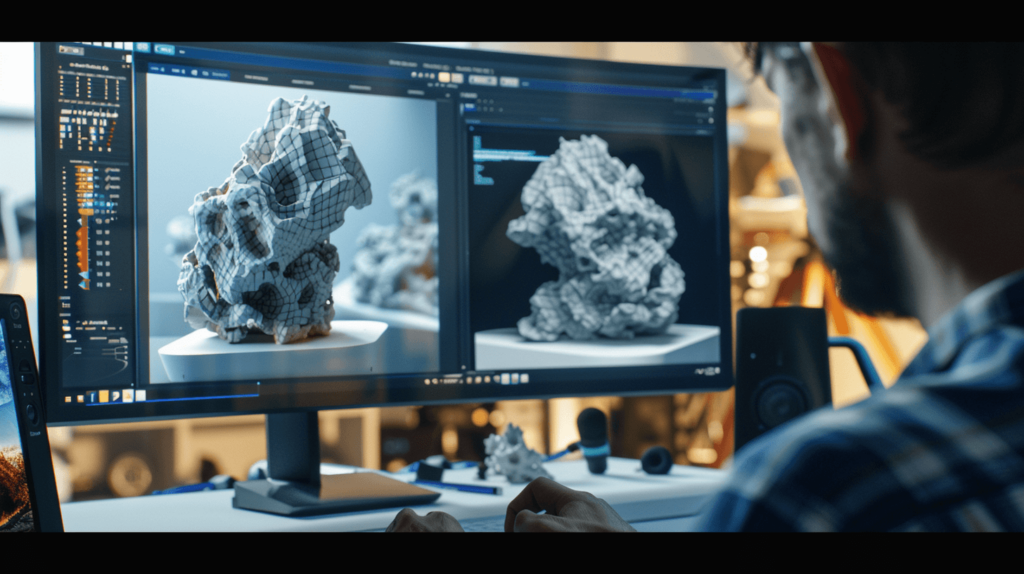Introduction

Visualize you’re at the helm of a dynamic company eagerly looking to hire a 3D modeler—a role pivotal to your project’s success. Crafting a meticulous and comprehensive job description is crucial in attracting not just any talent, but the right talent. A well-drafted job description acts as the cornerstone for sourcing skilled professionals who can navigate the complexities of 3D modeling across various industries. It must detail the specific skills and qualities necessary to meet the unique demands of your projects, ensuring that candidates are well-informed about the expectations and requirements before they apply.
For employers focused on securing the best talent in the market, finding a robust job description template is crucial. If you’re looking for a comprehensive foundation to draft your own hiring specifications, we have the perfect resource for you. Follow the link below to download our complimentary 3D Modeler Job Description template. This document is crafted with precision, incorporating the fundamental principles and best practices of C9Staff’s hiring methodology, ensuring you start on the right foot in attracting and hiring top-tier talent.
3D Modeler Job Description Template

3D modelers play diverse and critical roles in several fields, including entertainment, where they bring cinematic worlds to life; manufacturing, where they design components for everything from toys to high-tech machinery; and architecture, where they create detailed renderings of buildings before the first stone is laid. Their work is integral to innovating and shaping our visual and functional environment, making their contributions indispensable in the modern digital landscape.
This introduction lays the groundwork for a detailed exploration of the 3D modeler job role. It invites you to dig deeper into what makes an effective 3D modeler job description, guiding you through the distinctions of crafting a document that not only captures the essence of the role but also attracts the most qualified candidates who can propel your projects to success. Let’s explore how to craft a job description that resonates with the best in the field and ensures that your team is equipped to meet the challenges of tomorrow’s creative demands.
Understanding the Role of a 3D Modeler

3D modeling is an intricate fusion of art and technology, serving as the backbone of many industries that require precise visual representations. This process goes beyond mere creation of digital objects; it is a complex blend of creativity and technical expertise, where every curve and corner crafted in a virtual space has real-world implications. At its core, 3D modeling involves the development of mathematical representations of three-dimensional surfaces, objects, or living beings, typically manipulated via specialized software.
Industries Relying on 3D Modelers
The scope of work for a 3D modeler is vast and varied. In the entertainment industry, these professionals are crucial in bringing fantastical worlds to life—every creature and contraption you see in films and video games starts as a 3D model. In manufacturing, modelers play a key role in product design, helping companies visualize and refine products before they hit the assembly line. Architecture is another field heavily dependent on 3D modeling; here, modelers help envision future buildings and spaces, providing a tangible glimpse before the first brick is laid.
Daily Responsibilities of a 3D Modeler
A day in the life of a 3D modeler is filled with diverse tasks that require both creative genius and precision engineering. Common daily responsibilities include:
Creating Detailed 3D Renderings: Every project begins with detailed renderings that set the stage for further development and refinement.
Texturing: This involves adding surface textures to the 3D models, which enhances their realism and depth.
Rigging: For models that need to move, rigging is essential. This process involves creating the ‘skeleton’ that will allow the model to be animated.
Animating: Bringing models to life through motion, whether for films, games, or simulations.
Collaboration: 3D modelers often work closely with other creatives and technical staff, from designers and architects to engineers, ensuring that every model meets the required specifications and artistic vision.
Tools of the Trade
The tools used in 3D modeling vary by industry but typically include software like AutoCAD, Blender, and Maya. Each tool has its strengths, and the choice often depends on the specific requirements of the project and the industry.
Balancing Creativity and Technical Constraints
While 3D modeling offers a high degree of creative freedom, it also comes with its share of technical constraints. Modelers must constantly balance their artistic vision with the limits imposed by software capabilities, project deadlines, and client specifications. This balance requires not just technical skills but also an inventive mindset that can see beyond the current technology to what might be possible
Core Skills and Qualifications for a 3D Modeler

Proficiency in industry-standard software is fundamental for any 3D modeler. Tools such as AutoCAD, Blender, and Maya form the bedrock of 3D modeling work, facilitating everything from initial conceptual designs to sophisticated final renderings. Mastery of these programs allows modelers to execute complex designs with precision and efficiency. For those seeking to enhance their credibility in the field, obtaining technical certifications in these tools can be a significant advantage. These certifications not only validate a modeler’s skills but also demonstrate a commitment to staying current in a rapidly evolving industry.
Complementary Soft Skills
Beyond technical prowess, certain soft skills are essential to excel in 3D modeling. Creativity is at the heart of what it means to be a 3D modeler; it is the skill that enables professionals to envision and sculpt original models that may one day become animated characters, innovative products, or parts of expansive architectural designs. However, creativity must be paired with an acute attention to detail to ensure that the models are not only imaginative but also precise and functional within their intended scope.
Problem-solving is another critical soft skill. 3D modelers often face design challenges and technical constraints that require innovative solutions. Whether adjusting designs to meet client specifications or resolving software limitations, the ability to think critically and solve problems efficiently is crucial.
Educational Pathways and Continued Learning
The educational background of a 3D modeler typically includes a degree in computer graphics, animation, industrial design, or a related field. These programs provide foundational knowledge and hands-on experience in key areas of design and technology. Additionally, specialized training programs or credentials, particularly those that offer advanced coursework in cutting-edge technologies and techniques, are highly valued.
Continuous learning is vital in this field due to the rapid pace of technological advancements. Staying abreast of new tools, software updates, and industry trends is imperative for maintaining competitiveness and expertise in the market.
Are you ready to supercharge your career and land your dream job? C9Staff is here to help. Click the link below to submit your resume to our talent acquisition department. If your qualifications align with our client’s requirements, we’ll be in touch to explore potential opportunities that match your skills and aspirations. Don’t miss the chance to make your mark—submit your resume today and let us connect you with your next great opportunity.

Exploring the Spectrum: The Diverse World of 3D Modeling Careers
Crafting the Job Description for a 3D Modeler

The job title for a 3D Modeler should be clear and descriptive, reflecting the specific nature of the role and aligning with industry standards and expectations. A well-crafted job title not only captures the essence of the position but also ensures that it stands out in job search queries, attracting the right candidates. For instance, titles like “Senior 3D Modeler – Gaming” or “Architectural Visualization Specialist” specify both the rank and the industry focus.
When writing the job summary, aim to create a concise yet comprehensive description that outlines the core functions of the role and its significance within the organization. This summary should convey the essential duties of the position while highlighting the impact of these tasks on the broader company objectives. For example, a good job summary for a 3D Modeler might read: “As a pivotal member of our design team, you will lead the development of 3D models that transform client concepts into virtual realities, driving forward our commitment to innovation and excellence in digital design.”
Detailing Duties and Responsibilities
In the duties and responsibilities section, accurately list the key tasks that reflect the day-to-day activities of a 3D Modeler. This might include:
Designing and developing detailed 3D models based on initial sketches and client specifications.
Collaborating with designers, engineers, and architects to refine visual projects.
Applying advanced texturing and lighting techniques to enhance visualizations and prepare models for final production.
Be sure to describe these responsibilities clearly, emphasizing the balance of creativity and technical proficiency required. Explain how these tasks contribute to the overall project and business goals, such as improving client satisfaction, enhancing product design, or streamlining production processes.
Listing Qualifications and Skills
Guide the reader on how to effectively list qualifications and skills by suggesting an organized approach:
Technical Skills: Specify necessary software proficiency (e.g., expert in Blender, Maya, and AutoCAD), detailing the level of expertise required and any special functions the candidate should be familiar with.
Soft Skills: Highlight the need for creativity, problem-solving abilities, and attention to detail. Mention how these skills enable the modeler to overcome design challenges and contribute to team projects.
Educational Requirements: List preferred educational backgrounds, such as a degree in computer graphics, animation, or a related field, and mention any certifications or specialized training that are advantageous in the field of 3D modeling.
For employers focused on securing the best talent in the market, finding a robust job description template is crucial. If you’re looking for a comprehensive foundation to draft your own hiring specifications, we have the perfect resource for you. Follow the link below to download our complimentary 3D Modeler Job Description template. This document is crafted with precision, incorporating the fundamental principles and best practices of C9Staff’s hiring methodology, ensuring you start on the right foot in attracting and hiring top-tier talent.
3D Modeler Job Description Template

Industry-Specific Considerations for 3D Modeler Job Descriptions

Job descriptions for 3D modelers can vary significantly across different industries, reflecting the unique skills and responsibilities required in each sector. For instance, in the gaming industry, 3D modelers are primarily focused on character and environment creation. This role demands a deep knowledge of animation, texture mapping, and an ability to create engaging, dynamic environments that enhance the gaming experience. Conversely, in industrial design, the emphasis shifts to precision modeling of products where understanding engineering principles and material specifications are crucial. Here, modelers must ensure that their designs are not only aesthetically pleasing but also functional and manufacturable.
Impact of Emerging Technologies
Emerging technologies like virtual reality (VR) and 3D printing are reshaping the role of 3D modelers. VR is pushing the boundaries of what can be visualized and created, necessitating modelers in the entertainment and architecture industries to develop skills in new immersive environments. These professionals must now understand spatial design and user interaction within a virtual space, which are critical for creating realistic and engaging VR experiences.
Meanwhile, 3D printing is transforming the way products are prototyped and manufactured. 3D modelers in this field need a thorough understanding of material properties and the structural integrity of designs. Their work now directly contributes to innovations in various industries, from medical devices to automotive manufacturing, where prototypes can be rapidly produced and tested.
Tailoring Job Descriptions to Industry Needs
When crafting job descriptions, it’s essential to tailor the summary to reflect the specific technological demands and creative challenges of the industry. For a 3D modeler in the film industry, the job description might highlight experience with cinematic effects and proficiency in real-time rendering tools that are crucial for creating visually stunning movie scenes. In contrast, a job description for a modeler in manufacturing might focus on expertise in CAD software and technical drawing, essential skills for creating detailed and accurate product designs.
Strategic Considerations for Hiring
HR professionals and hiring managers should consider not only the current requirements of the role but also how emerging trends might influence the skills needed in the future. It’s crucial to think strategically about the qualifications and experiences highlighted in the job descriptions. This approach ensures that candidates are not only fit for the role today but are also capable of growing with the industry’s evolving demands.
Encourage these professionals to integrate both current needs and future growth opportunities into the job description. This strategy will attract candidates who are adaptable and eager to develop new skills, thereby future-proofing the workforce against rapid technological changes.
Attracting the Right Talent for 3D Modeler Positions

Attracting high-quality candidates for 3D modeler roles begins with offering competitive compensation that aligns with industry standards. It’s essential to understand the typical salary ranges for these positions, which can vary based on factors like experience, location, and industry sector. To appeal to a broader range of candidates, consider implementing a salary scale that adjusts for different levels of expertise and responsibilities.
Beyond salary, comprehensive benefits play a crucial role in demonstrating the company’s commitment to employee welfare. A robust benefits package might include health insurance, retirement plans, performance bonuses, and other perks such as flexible working conditions. These benefits not only enhance the compensation package but also show the company’s dedication to supporting its employees’ professional and personal lives.
Aligning with Company Culture and Growth Opportunities
The job description is a pivotal tool for communicating the company’s culture and values. Ensuring that it resonates with candidates who share similar ideals can significantly impact the quality of applicants. Highlight the company’s mission and core values within the job description to attract candidates who are likely to thrive in and contribute positively to the company culture.
Furthermore, outlining clear career advancement opportunities within the company can attract ambitious professionals seeking long-term growth. Detail potential professional development paths, such as leadership roles, specialized projects, or sponsorship for further education and certifications. This not only attracts talent but also fosters loyalty and motivation among team members.
Effective Job Description Strategies
To effectively weave these elements into a job description, focus on specific phrases and sections that highlight the company’s unique attributes. For example, if the company prides itself on innovation, mention how the role contributes to pioneering projects or the development of cutting-edge technologies. If work-life balance is a cornerstone of the company culture, detail policies like remote work options or flexible hours.
Suggestions for phrases might include:
“Join a team that is dedicated to redefining the industry standards, offering opportunities to work on groundbreaking projects.”
“We support your professional growth through continuous learning opportunities and certifications.”
“Our company values work-life balance, providing flexible scheduling to help you manage personal and professional commitments effectively.”
If you’re looking to enhance your team with the best talent for a 3D Modeler position, C9Staff is here to guide you through every step. From sourcing and recruiting to training and managing, we ensure you find the perfect fit for your organization. Click the link below to schedule a free exploratory call with one of our experienced account managers today. We will listen carefully to your needs and provide endorsements for potential candidates at no cost, helping you evaluate the top talent available at competitive prices.

Conclusion: Mastering the Craft of 3D Modeler Job Descriptions

In this guide, we’ve explored the multifaceted role of 3D modelers across various industries and underscored the pivotal skills required in this dynamic field. From mastering technical tools like AutoCAD, Blender, and Maya to cultivating indispensable soft skills such as creativity and problem-solving, the scope of a 3D modeler’s contributions is vast and varied. We’ve also examined how the nuances of job descriptions should be tailored to meet the unique demands of sectors like gaming, film, and industrial design, while also considering how emerging technologies such as virtual reality and 3D printing are reshaping these roles.
A well-constructed job description is more than a list of duties and requirements; it’s a strategic tool that attracts the right candidates and sets the groundwork for future success. By offering competitive compensation, outlining comprehensive benefits, and clearly defining pathways for career advancement, companies can attract high-quality candidates who are not only capable but also motivated to grow alongside the business.
To all employers—whether you are HR professionals crafting these descriptions or managers overseeing the hiring process—your approach to developing job descriptions should be as detailed and thoughtful as the designs your 3D modelers will create. Consider the broader impact of your efforts: a well-drafted job description does more than fill a vacancy. It builds the foundation of a strong, innovative team that will propel your company forward in a competitive landscape.
Let this guide serve as your blueprint to attracting and retaining the top talent in the 3D modeling industry, ensuring that your team is not just equipped for the challenges of today but is also future-proofed against the evolving demands of tomorrow.




